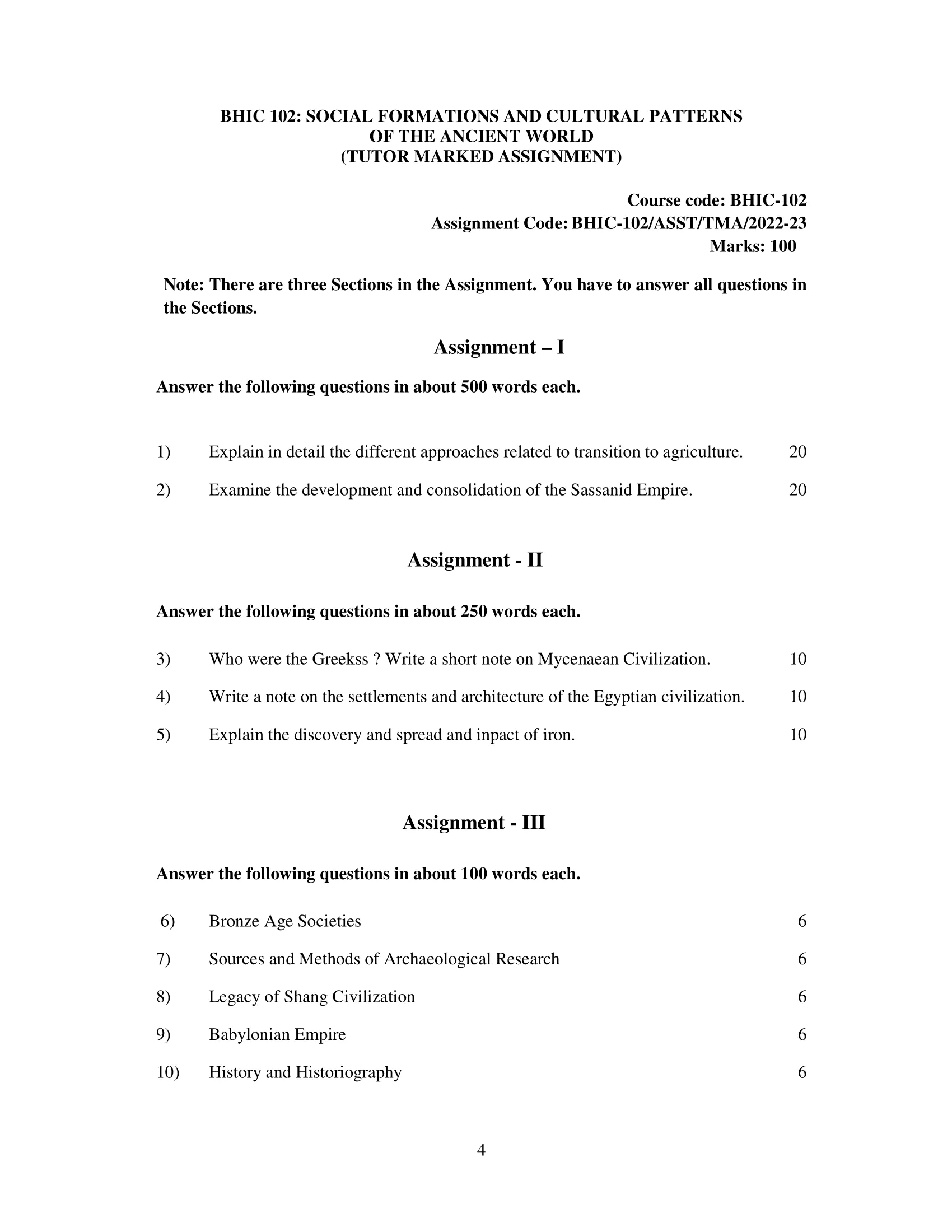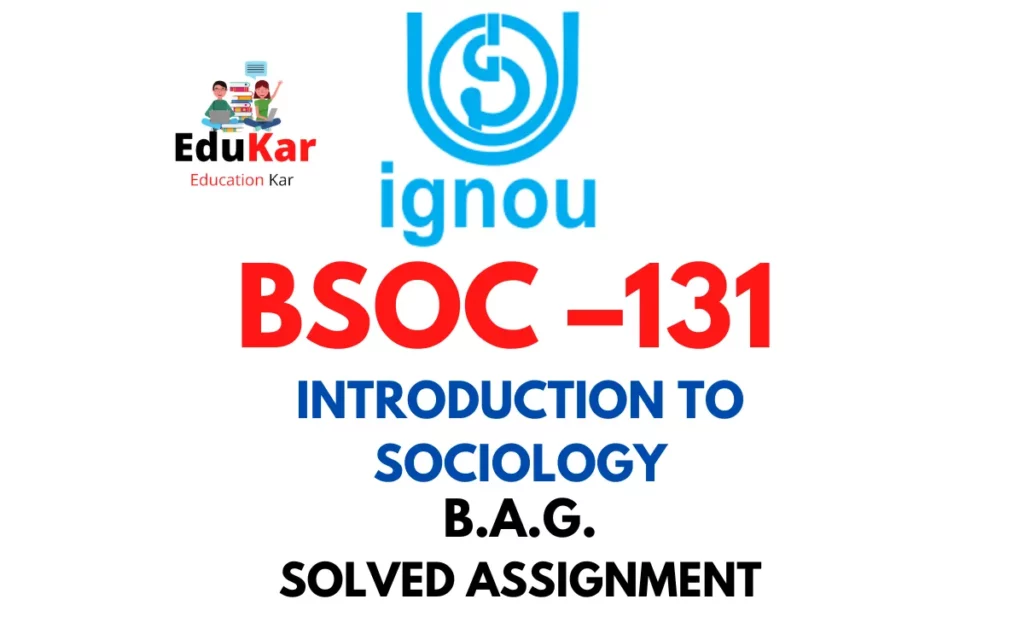Contents
- 1 Assignment – I
- 2 Answer the following questions in about 500 words each.
- 3 1) Explain in detail the different approaches related to transition to agriculture.
- 4 2) Examine the development and consolidation of the Sassanid Empire.
- 5 Assignment – II
- 6 Answer the following questions in about 250 words each.
- 7 3) Who were the Greekss ? Write a short note on Mycenaean Civilization.
- 8 4) Write a note on the settlements and architecture of the Egyptian civilization.
- 9 5) Explain the discovery and spread and inpact of iron.
- 10 Assignment – III
- 11 Answer the following questions in about 100 words each.
- 12 6) Bronze Age Societies
- 13 7) Sources and Methods of Archaeological Research
- 14 8) Legacy of Shang Civilization
- 15 9) Babylonian Empire
- 16 10) History and Historiography

| Title | BHIC-102: IGNOU BAG Solved Assignment 2022-2023 |
| University | IGNOU |
| Degree | Bachelor Degree Programme |
| Course Code | BHIC-102 |
| Course Name | SOCIAL FORMATIONS AND CULTURAL PATTERNS OF THE ANCIENT WORLD |
| Programme Name | Bachelor of Arts (General) |
| Programme Code | BAG |
| Total Marks | 100 |
| Year | 2022-2023 |
| Language | English |
| Assignment Code | BHIC-102/ASST/TMA/2022-23 |
| Last Date for Submission of Assignment: | For June Examination: 31st April For December Examination: 30th September |

Assignment – I
Answer the following questions in about 500 words each.
Ans: The transition to agriculture is considered one of the most significant events in human history, as it marked the shift from a hunter-gatherer lifestyle to a more sedentary, agrarian-based one. Over the years, scholars have proposed various approaches to explain this transition, including ecological, demographic, technological, and cultural explanations.
Ecological approaches suggest that the transition to agriculture was driven by environmental factors, such as changes in climate, availability of resources, and fluctuations in the abundance of wild plants and animals. This approach suggests that as the environment changed, humans were forced to adopt new forms of subsistence, such as agriculture, in order to meet their basic needs.
Demographic approaches focus on population growth as a key factor in the transition to agriculture. This approach suggests that as populations grew, they needed to find more reliable and sustainable sources of food, leading to the development of agriculture. This approach is often linked to the ecological explanation, as population growth may have been driven by changes in the environment that created new opportunities for food production.
Technological approaches emphasize the role of technological innovations in the transition to agriculture. This approach suggests that humans developed new technologies, such as irrigation, plows, and seeds, that allowed them to increase their food production and rely less on hunting and gathering. This led to the development of more complex societies, as people could produce more food than they needed and trade the surplus.
Cultural approaches suggest that the transition to agriculture was driven by cultural factors, such as beliefs, values, and social norms. This approach suggests that agriculture was adopted as a form of subsistence because it was seen as desirable or necessary for social, economic, or religious reasons. For example, some societies may have adopted agriculture as a way to demonstrate their wealth, power, or social status.
Finally, recent research has integrated elements from all of these approaches and adopted a more nuanced view of the transition to agriculture. This research suggests that the transition was likely the result of complex interactions between environmental, demographic, technological, and cultural factors.
2) Examine the development and consolidation of the Sassanid Empire.
Ans: The Sassanid Empire was a Persian dynasty that ruled the ancient Persian Empire from 224 CE to 651 CE. The development and consolidation of the Sassanid Empire was a complex process that involved the establishment of a centralized government, the expansion of territories, and the construction of a strong military.
The Sassanid dynasty was established by Ardashir I, who overthrew the Parthian Empire and established a new dynasty. Ardashir I was able to consolidate his power by establishing a centralized government, creating a new administrative system, and constructing a strong military. He also established a new capital city at Ctesiphon, which became the center of the Sassanid Empire.
Under the Sassanids, the empire expanded its territories through military conquests, taking control of territories in present-day Iraq, Iran, Afghanistan, and Central Asia. The expansion of the empire brought significant wealth and resources, which allowed the Sassanids to build a strong economy and infrastructure. The development of agriculture, trade, and commerce was encouraged, and the empire became one of the major economic powers of its time.
The Sassanids also made significant contributions to art, culture, and religion. They supported the development of Zoroastrianism as the dominant religion, and built many fire temples, which became centers of religious worship. They also supported the arts, constructing beautiful palaces, gardens, and monuments that reflected the wealth and cultural achievements of the empire.
The military power of the Sassanid Empire was demonstrated by the long-standing wars against the Roman Empire, which lasted for over four centuries. Despite the frequent conflicts, the two empires maintained a diplomatic relationship and even engaged in cultural exchange. The Sassanids were also able to successfully defend their empire against foreign invasions, including the Arab-Muslim conquest in the 7th century.
Assignment – II
Answer the following questions in about 250 words each.
3) Who were the Greekss ? Write a short note on Mycenaean Civilization.
Ans: The Greeks were a group of Indo-European peoples who inhabited the southern Balkans, including present-day Greece, during the classical period (5th to 4th centuries BCE). They developed a unique culture and civilization that has had a profound impact on Western culture and civilization.
The Mycenaean Civilization was a civilization that existed in Greece from 1600 BCE to 1100 BCE. It was characterized by the development of palace-centered states, the use of a writing system known as Linear B, and a rich artistic tradition. The Mycenaeans were skilled metalworkers, and their artifacts such as jewelry, weapons, and pottery have provided valuable insight into their society.
The Mycenaeans built impressive fortifications and palaces, including the famous city of Mycenae and its palace complex. They also engaged in trade with other civilizations in the eastern Mediterranean, importing luxury goods from Egypt, the Near East, and Asia Minor. The Mycenaean civilization was a dominant power in the Aegean region and its influence extended to the islands and coastal cities of the eastern Mediterranean.
The Mycenaeans were conquered by the Dorians, another Indo-European group, around 1100 BCE. This marked the end of the Mycenaean civilization and the beginning of a period of instability known as the Greek Dark Ages. However, the cultural and intellectual achievements of the Mycenaeans had a lasting impact on the Greeks, who later developed the classical civilization of ancient Greece.
4) Write a note on the settlements and architecture of the Egyptian civilization.
Ans: The settlements and architecture of the ancient Egyptian civilization were a reflection of the wealth, power, and cultural achievements of the civilization. The ancient Egyptians built a variety of structures, including temples, pyramids, palaces, and houses, which reflected their religious beliefs, political power, and social status.
The ancient Egyptians built settlements along the banks of the Nile River, where they had access to water for agriculture and transportation. These settlements were organized into cities, which were centered around temples, palaces, and other public buildings. The cities also had residential areas, where the common people lived.
The most famous architectural achievement of the ancient Egyptians was the pyramids, massive structures built as tombs for the pharaohs and their consorts. The largest and most famous pyramid is the Great Pyramid of Giza, which was built during the reign of Pharaoh Khufu. The pyramids were built using highly sophisticated techniques, and they remain an impressive testament to the engineering and architectural skills of the ancient Egyptians.
The temples were also important architectural achievements of the ancient Egyptians. These structures were built to honor the gods and served as centers of religious worship. The temples were also used for political and economic purposes, as they housed the archives and treasury of the state.
5) Explain the discovery and spread and inpact of iron.
Ans: The discovery and spread of iron had a profound impact on the ancient world and helped to usher in a new era of human civilization. Iron is a stronger and more durable metal than copper and bronze, which were the primary metals used for tools and weapons prior to the Iron Age.
The exact origins of iron smelting are uncertain, but it is believed to have been discovered independently by several cultures in different parts of the world, including the Hittites in Anatolia (modern-day Turkey), the ancient Egyptians, and the peoples of the Indian subcontinent. The Hittites were among the first to develop iron-making technology on a large scale, and their iron weapons and tools gave them a military advantage over their enemies.
The spread of iron technology was facilitated by trade, migration, and the movement of people and ideas. By the 1st millennium BCE, iron-making had spread to the rest of the ancient world, including Europe, Africa, and China. The widespread availability of iron tools and weapons led to significant advancements in agriculture, mining, and construction, as well as increased efficiency in war.
The impact of iron was felt in many areas of society. Iron weapons gave armies a significant advantage over those armed with bronze or copper weapons, leading to changes in military tactics and the development of larger and more complex states. The increased efficiency of iron tools and weapons also led to the growth of trade and commerce, as iron products were in high demand.
Assignment – III
Answer the following questions in about 100 words each.
6) Bronze Age Societies
Ans: The Bronze Age was a period in human history characterized by the widespread use of bronze for tools and weapons. It lasted from around 3300 BCE to 1200 BCE and was a significant time of social and cultural development. Bronze Age societies were typically organized into city-states or kingdoms, and their economies were based on agriculture, trade, and metalworking. Bronze Age societies saw the rise of monumental architecture, such as the pyramids of Egypt, the ziggurat of Mesopotamia, and the bronze-age palaces of the Aegean. They also saw the development of early writing systems, such as cuneiform and hieroglyphics, and the growth of trade networks that connected civilizations across vast distances.
7) Sources and Methods of Archaeological Research
Ans: Archaeological research involves the study of past human cultures and societies through the excavation and analysis of artifacts, structures, and other physical remains. There are various sources and methods of archaeological research, including field surveys, excavation, laboratory analysis, and the study of written records. Archaeologists use a range of techniques, including carbon dating, stratigraphy, and artifact analysis, to gather information about the age, use, and cultural context of the artifacts and structures they study. In addition, they also use GIS technology and remote sensing methods, such as aerial photography and ground-penetrating radar, to map and study archaeological sites. The goal of archaeological research is to understand the past and gain insights into the development of human cultures and societies over time.
8) Legacy of Shang Civilization
Ans: The Shang civilization, which existed in ancient China from the 16th to the 11th centuries BCE, left a significant legacy in Chinese history and culture. The Shang are credited with developing the first written language in China, known as Oracle Bone Script, which was used to record astronomical observations, divinations, and other important events. They also made advances in bronze metallurgy and created elaborate bronze vessels for religious rituals. The Shang are also known for their construction of large settlements, including the city of Yin, which was the capital of the Shang dynasty. The legacy of the Shang includes the continued use of bronze metallurgy and the development of a writing system that would eventually lead to the creation of the Chinese script. The Shang dynasty also paved the way for the later development of the Zhou dynasty, which established the concept of the Mandate of Heaven, which would influence Chinese political thought for centuries to come.
9) Babylonian Empire
Ans: The Babylonian Empire was an ancient Mesopotamian state that existed from the 18th to the 6th centuries BCE. It was centered in the city of Babylon, located in present-day Iraq, and controlled a vast territory that included parts of modern-day Iran, Iraq, and Syria. The Babylonian Empire was ruled by a series of powerful kings, including Hammurabi, who established a comprehensive legal code known as the Code of Hammurabi. The Babylonians were known for their innovations in architecture, including the construction of the Hanging Gardens, one of the Seven Wonders of the Ancient World. They also made significant contributions to the fields of mathematics, astronomy, and astrology. The legacy of the Babylonian Empire includes its influence on the development of Western civilization, particularly through its contributions to law, science, and culture.
10) History and Historiography
Ans: History is the study of past events, people, and societies, while historiography is the study of how history is written, researched, and analyzed. It includes the study of the various methods, theories, and perspectives used by historians to interpret and understand the past. Historiography also encompasses the examination of historical sources, including written records, artifacts, and other physical remains, and how these sources are used to construct narratives about the past. The study of historiography is important because it helps historians to understand how historical knowledge is constructed and how different interpretations of the past are shaped by the perspectives and biases of those who write it. It also enables us to recognize the limitations and strengths of different historical sources and to critically evaluate the interpretations and claims made by historians.
How to Download BHIC-102 Solved Assignment?
You can download it from the www.edukar.in, they have a big database for all the IGNOU solved assignments.
Is the BHIC-102 Solved Assignment Free?
Yes this is absolutely free to download the solved assignment from www.edukar.in
What is the last submission date for BHIC-102 Solved Assignment?
For June Examination: 31st April, For December Examination: 30th October















